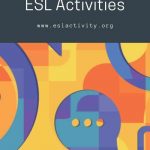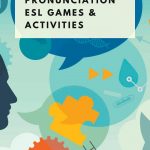The “Family” unit is a classic is almost every single ESL/EFL textbook, especially for beginners. It can be a little bit boring for the teacher, as well as the students if you do the same old thing all the time. Check out some of my favourite family ESL activities to try out with your classes today. They range from beginner to advanced, and kids to adults.
ESL Family Activities and Games

ESL family games and activities
Let’s get into the best ESL family tree activities and ESL family games. Keep on reading for our top options for family tree ESL ideas.
#1 ESL Family Games: Mixed up Sentences
If you’re teaching beginners the basics of how to describe their family, then you might want to consider using this grammar review activity.
You can use sentences like:
“I have a brother and two sisters.”
“My Mom is 48 years old and my dad is 45.”
“My brother likes to play soccer.”
You mix them up in random order and the students have to unscramble them to make correct sentences. Learn more here: Mixed Up Sentences Review Activity.
#2 ESL Family Activity: Picture Prompt
This ESL Family Activity works for just about any topic actually. The way it works is that you put a picture or photo up on the screen. In this case, you’d probably want to show a family doing some activity. Then, depending on the level, students have to say vocabulary words they see in the picture (beginner), or describe what’s happening (more advanced).
It’s a nice way to begin a class as it helps to set the context. Check out more details here: Picture Prompt ESL Warm-Up.
#3: Information Gap Activities
This style of ESL activity is a classic! It’s where there is a single set of information, but each student only has some of it. They have to work together to put the whole story together.
Information gaps lend themselves well to stories of another family (not their own). Instead of just reading it, do this kind of activity to make it more memorable.
Find out more here: ESL Information Gap Activities.
#4: Just a Minute
If you teach more advanced-level students, then you’ll want to consider using this Toastmaster style activity. Students have to speak for an entire minute about their families without stopping. It’s a nice warm-up, or you could consider using it at the end of class as well.
To turn it into more of a conversational activity, put students into groups of 4. Then, each of the 3 students who were listening has to ask 1-2 follow-up questions based on what they heard.
Check it out here: Just a Minute ESL Speaking Activity.
#5: Just One Question
This is a fun warm-up activity that gets students out of their seats and moving around the class. If you have sleepy students, it may be your ideal solution!
Put students into pairs and then ask them to think of some interesting questions related to family (around 5). Then, they choose just 1 that they want to survey their classmates about.
Give students time to ask 8-12 of their classmates and take notes about the answers (1 member of the pair is the “talker” and the other is the “writer”). Then, students take a look at their answers, find some patterns and then report their results to the class.
You can learn more about it here: Just One Question ESL Warm-Up.
#6: Typhoon
The ideal way to review just about anything, including family vocabulary is with this game. Check it out:
#7: Journalling about Family
If you teach writing, or even a 4-skills class, consider using journaling with your students. You can give them a few minutes at the beginning or end of a class to do this, or assign it for homework.
I generally assign my students a topic or question to help them get started. Some questions about family that you could use include the following:
- Describe your family.
- What qualities do you admire in your Mom and/or Dad?
- How does your family spend time together?
- What’s your favourite memory of your family?
Find out more here: Journalling for English Learners.
- Amazon Kindle Edition
- Smith, Jennifer Booker (Author)
- English (Publication Language)
- 144 Pages - 03/31/2016 (Publication Date)
#8 ESL Family Activities: Dictogloss
This ESL activity can focus on either speaking or writing, and either way, it’s heavy on the listening. Choose a reading passage related to family. Then, read it out at a mostly normal pace so that the students can grasp around 50% of the information.
Put the students into pairs and they have to work together to recreate the main idea of what they heard. Then, read it again and students can add more information.
At the end, put the reading passage on the screen and students can check and see how they did. Find out more here:
#9: Family and Relative Clauses
Relative clauses and the topic of family are often put together in ESL textbooks. It just lends itself well to this in my ways. Think about these example sentences:
- My father is someone WHO is very trustworthy.
- I have a brother THAT can play the guitar.
Find out more about how to teach this grammar point here: How to Teach Relative Clauses.
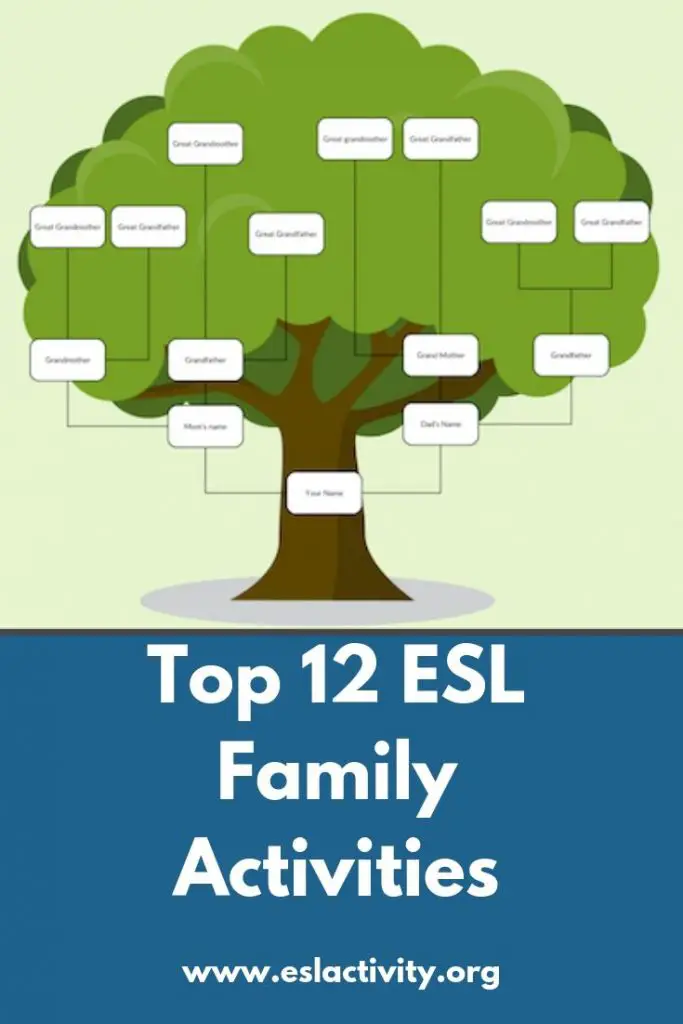
Family ESL Games and Activities
#10 Family ESL Activity: Speaking Fluency Activity
120-90-60 is a way to encourage students to speak more fluently. Have students prepare a short talk about their family, around 2 minutes long. They can write a few short notes, but not full sentences. Then, they give their speech to a partner or small group.
The next round requires them to include all the same information in 90 seconds. Round 3 is 60 seconds. It’s a fun challenge that students have fun with! Of course, the topic you’d set would be something related to family in this case, although it lends itself well to almost anything.
English Speaking Activity (Fluency).
#11: Family ESL Surveys
I’m ALL about using surveys in my TEFL classes. Just ask my students and they’ll tell you that they have to do them around once a month, if not more. There are a few reasons that I love them:
- Students have to get out of their seats
- They cover all 4-skills
- You can use them for almost any topic (including family)
- It’s simple to make your own in just a few minutes
- They help students with follow-up questions
Check out some examples of surveys I use in my classes here: Surveys for ESL Students.
#12: ESL Family Trees
Making an ESL family tree is a classic activity for this unit. Depending on the level of student, you could make it as simple, or as detailed as you want. It’s an ideal way to review ESL family vocabulary, and it also makes a nice homework assignment, or class presentation.
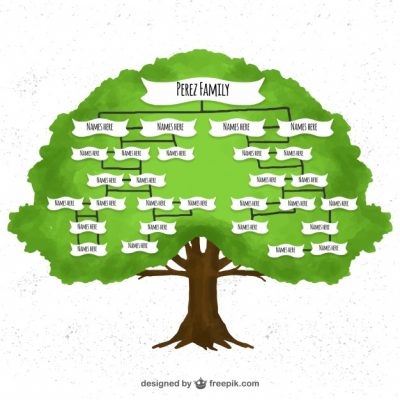
Family Tree ESL
How you do your ESL family tree activity is up to you, but I strongly recommend checking the textbook that you’re using. They’ll often have a page with a family tree already there.
The next best option is to print off a simple, blank family tree from the Internet and have students fill it in. A way to extend this activity is to have your ESL students share their tree with a partner or small group (bigger classes) or to the whole class (smaller classes). Be sure to give them some example sentences that they can use to describe their ESL family trees.
#13: ESL Family Vocabulary
If you have a textbook that you’re teaching from, the basic family vocabulary words will almost always be included. More advanced books will include things like niece, nephew, step-brother, etc. However, if you’re not using a book but want to teach your students this vocab, there are plenty of worksheets out here.
Here’s one of my favourites:
Or, here are some of the most common words related to family that you’ll want to teach your students:
- Mom
- Dad
- Grandpa
- Grandma
- Grandparents
- Great-grandparents
- Parents
- Aunt
- Uncle
- Niece
- Nephew
- Stepmom/dad
- Relative
- Brother
- Sister
- Son
- Daughter
- Amazon Kindle Edition
- Smith, Jennifer Booker (Author)
- English (Publication Language)
- 85 Pages - 12/24/2015 (Publication Date)
#14 ESL Family: Yes and No Question/Answer Activities
One of the first grammar lessons that most beginners learn in English is the “Be” verb. And one of the most common topics to combine this with is “family.” It’s very easy to explain to even total beginners the concepts of: mother, father, brother, sister, etc.
Taking these two things together, there are a ton of simple concept check questions you could ask:
- Do you have a brother?
- Are there four people who live at your house?
- Is there a mom and dad in the picture?
- Do you see three children?
For more ideas, you’ll want to check out the following: ESL Yes or No Activities.
#15 ESL Family Activities: Using the Whiteboard
I don’t know what it is, but my students are ALL about drawing on the whiteboard. There are a ton of fun activities you can do with the whiteboard and the topic of family. If you want to see some of them, then you’ll need to take a look at this awesome resource:
ESL Whiteboard Games and Activities.
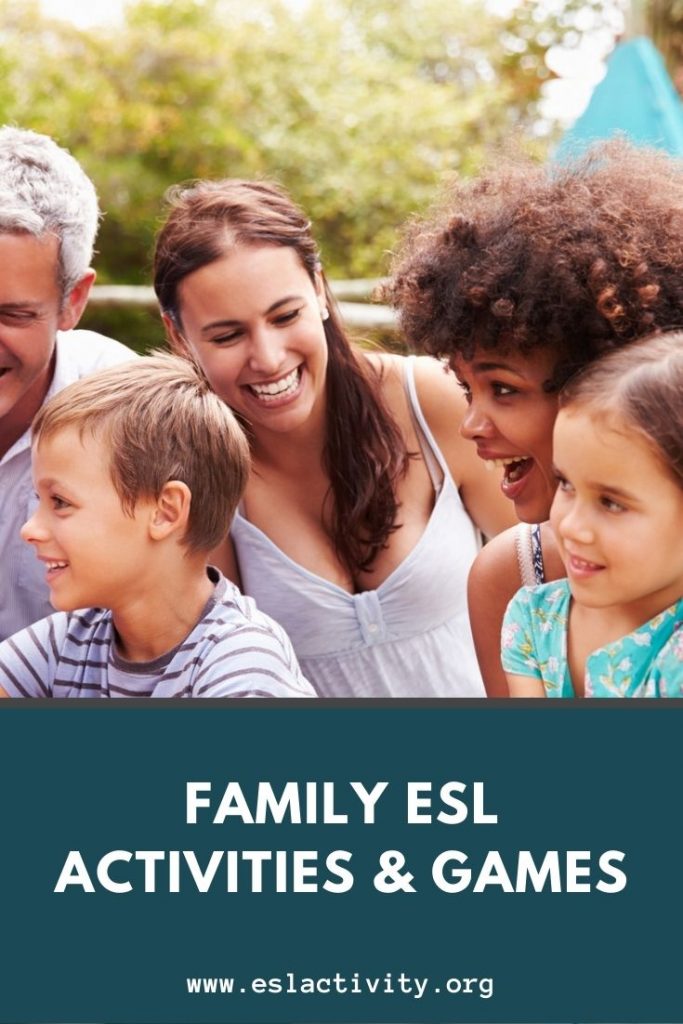
ESL family tree
#16 ESL Family Vocabulary Game: A to Z
If your students have seen family vocabulary before, then you may want to consider using this quick warmer activity to help them activate their prior knowledge before jumping into the heart of your lesson.
The way it works is that each group (2-3 students) writes down the alphabet. Then, they try to think of one family related vocabulary word for each letter. For example:
B=brother
D=Dad
G=Grandmother
And so on. The winner is the team with the most points at the end of the allotted time. More details about this quick ESL vocabulary warm-up right here: A-Z ESL Warmer.
#17: ESL Family Songs and Chants
If you teach kids, then songs and chants are some ESL teaching gold! However, if you don’t have a musical bone in your body (like me), not to worry. There are lots of good ones on YouTube to consider for any age and level of student.
#18: Speaking Fluency Activity
To use this activity with the family unit, have students talk about a family member that they know really well.
#19: Using Eliciting for ESL Family Vocabulary
Unless your students are true beginners, it’s likely that they already know at least the basic family vocabulary like mom, dad, brother, sister, grandma, etc. If that’s the case, consider starting off your classes by eliciting some of these words. There are two reasons to consider doing this.
The first is that you’re able to find out what the students already know so it’s possible to target the lesson more specifically to what they don’t. The second reason is that it’s useful for activating the students’ prior knowledge so that the new words they learn can be easier to remember. Check out some of the best ideas for doing this:
#20: Concentration Vocabulary Memory Game
One of the best games to help students review new vocabulary is concentration. Make up some cards with either words/definitions, words/hints, or words/pictures of the various family vocabulary. What you choose to do really depends on the level of the students.
Then, students play a matching memory game with each other. Find out more about it here: ESL Concentration Game.
#21: Fun TEFL Games for Teaching about Family
#22: Word Association ESL Families
A nice warmer activity for the unit on family if your students are not beginners is word association. Elicit some words that students think of when they hear the word “family.” Then, organize them into various
#23: Me Too!
This is a simple speaking and listening activity. Students have to make a true statement about their families. For example:
- I have a twin.
- My grandparents live with me.
- I have a younger brother.
If other students can agree, they stand up and say, “Me too!”
#24: Running Dictation
#25: Family Interviews
Encourage students to interview their family members about their interests, hobbies, and daily routines. In class, students can share what they learned, using sentences and vocabulary related to family and personal information. This activity helps build communication skills and vocabulary.
#26: Family Photo Gallery
Ask students to bring in family photos and create a classroom photo gallery. Each student can share their photos and talk about their family members, using adjectives to describe them and sentences to explain the significance of each photo.
#27: Family Cookbook
Have students collect family recipes and create a class cookbook. They can write or dictate the recipes in English, including ingredients, instructions, and personal stories or memories associated with each recipe. This activity promotes reading, writing, and speaking skills.
#28: Family Storytelling
Encourage students to share stories about their family traditions, memorable events, or experiences. Students can prepare a short narrative and present it to the class, incorporating descriptive language and sequencing words.
ESL Family Worksheets
Do you want some ready-made family worksheets for your English learners? Then you’ll need to check out some of our favourite resources right here. And of course, be sure to check out the textbook you’re using, along with the homework book or teacher’s resource book which often has some excellent resources to use in your classes.
Family ESL Worksheets:
Be sure to check out these resources as well if you’re looking for some ESL family tree worksheets. There are lots of them there, ranging from very simple to a bit more complicated.
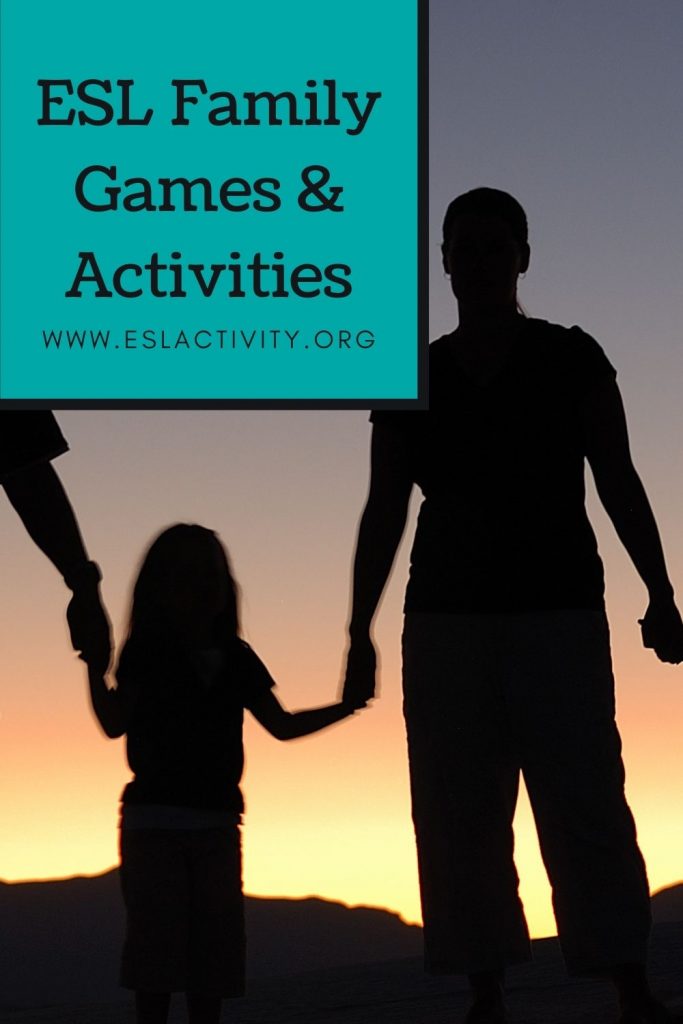
ESL families activities and games
What about a Family ESL Lesson?
If you’re looking for a ready-made ESL family lesson plan or two, then these activities and games probably didn’t work for you. Not to worry. Here are some of our top picks for complete lesson plans for the family:
Or, you might consider planning your own conversation lesson. Find out how here:
Did you like these ESL Family Activities?
- Amazon Kindle Edition
- Bolen, Jackie (Author)
- English (Publication Language)
- 187 Pages - 03/09/2016 (Publication Date)
Yes? Though so. Then you’re going to love this book available on Amazon: 101 ESL Activities for Adults. It’s the book you need if you want to have more interesting, engaging English lessons.
The best part is that it’s divided up into easy to find sections. You can look for speaking, listening, reading, writing, review, grammar or 4-skills games and activities in seconds and find what you’re looking for in just a minute or two. Now, if that’s not some English teaching awesome, then I don’t know what is.
You can get the book in a couple of different formats. Take the e-version with you on your phone or tablet to your favourite coffee shop for lesson planning on the go. Or, get the physical version and keep it on the bookshelf in your office to use as a handy reference guide. It really is that easy to have better English lessons.
Check out the book for yourself today, but only if you want to get yourself a serious dose of ESL teaching awesome in your life:
FAQs
There are a number of common questions that people have about teaching this unit. Here are the answers to some of the most popular ones.
Why is teaching the family unit important in ESL/EFL?
Teaching the family unit is important because it is a fundamental aspect of everyday life and provides language learners with vocabulary and language structures relevant to personal relationships and descriptions.
How can teachers introduce the family unit to ESL/EFL learners?
Teachers can introduce the family unit by using visuals, real-life photos, or flashcards to teach family members’ names and relationships. They can also incorporate related vocabulary, such as adjectives to describe family members or possessive pronouns to show ownership.
What activities can teachers use to teach the family unit?
Teachers can use activities like family tree projects, role-plays, drawing or describing family members, and creating dialogue or narrative exercises centered around family relationships to teach the family unit.
How can teachers promote cultural awareness while teaching the family unit?
Teachers can promote cultural awareness by discussing and comparing family structures and traditions across different cultures, sharing personal experiences, or incorporating multicultural materials that depict diverse family units.
What language skills can be practiced when teaching the family unit?
Teaching the family unit provides opportunities to practice various language skills such as listening (listening to descriptions of family members), speaking (describing family members or answering questions), reading (reading texts or descriptions about families), and writing (writing about one’s own family or creating fictional stories).
How can teachers personalize the family unit lessons for ESL/EFL learners?
Teachers can encourage students to share information about their own families, ask them to create profiles or presentations about their family members, or provide opportunities for students to discuss cultural aspects of their family backgrounds.
Are there any cultural considerations to keep in mind when teaching the family unit?
Yes, teachers should be sensitive to cultural differences and avoid making assumptions about family structures. It is important to create a safe and inclusive environment where students feel comfortable discussing their families and cultural backgrounds.
What resources can be used to teach the family unit?
Resources such as textbooks, picture books, videos, online interactive exercises, and authentic materials like family photos or interviews can be used to teach the family unit.
How can teachers assess students’ understanding of the family unit?
Teachers can assess students’ understanding of the family unit through activities like quizzes, oral presentations, writing assignments, or by observing their ability to describe family members or engage in conversations about family relationships.
How can teachers extend the family unit topic to further language learning?
Teachers can extend the family unit topic by incorporating related language skills and topics such as describing physical appearance, discussing family traditions, talking about hobbies or interests, or exploring other topics related to personal relationships and communities.
Have your say about these ESL Family Activities
What are your thoughts about these family ESL games and activities? Did you try them out in your classes? Do you have a recommendation for an ESL family tree worksheet for kids or adults? Leave a comment below and let us know your thoughts. We’d love to hear from you.
Also be sure to give this article a share on Facebook, Pinterest, or Twitter. It’ll help other busy teachers, like yourself find this useful teaching resource.
Last update on 2022-07-17 / Affiliate links / Images from Amazon Product Advertising API





